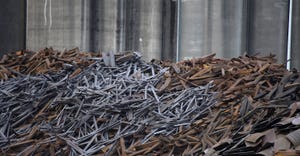TRC Cos. of Lowell, Mass., has pioneered a new use for spent foundry sands that could save the iron-casting byproduct from taking up valuable landfill space, as well as providing a new solution in landfill barriers.
The development by TRC recently garnered the attention of the American Council for Engineering Companies’, which awarded TRC its National Recognition Award earlier this month for exemplary engineering achievement.
TRC’s discovery emerged from collaborating with Waupaca Foundry Inc. (WFI). The groups were looking to find ways to reduce landfill costs and reuse foundry byproduct, thereby reducing the environmental impact of the substance.
WFI owns and operates a non-hazardous waste disposal facility in Waupaca, Wis., that receives byproducts from three of the company’s nearby foundries. The foundries produce gray and ductile iron castings using a “green sand” casting process. The sands, which also contain bentonite clay, are used many times for casting before it is considered spent. Traditionally, spent foundry sand was destined to be sent to the non-hazardous landfill.
But TRC and WFI discovered that when properly hydrated and compacted, the bentonite-containing sands can be used as a low water permeability barrier product.
TRC and WFI constructed test pads using the sand byproduct as landfill liner material, and ultimately earned approval from the Wisconsin Department of Natural Resources in May 2014 to utilize the byproduct material as a barrier later in the landfill liner system.
According to TRC, the reuse of the sand byproduct reduces the amount of materials WFI deposits into its landfill as waste by 80,000 cubic yards. Additionally, the design of the landfill liner using the byproduct reduces liner requirements from four ft. of clay to two ft. of sand byproduct material overlaid by a geomembrane.
“The unique part of this is it’s a foundry sand that’s classified as clayey sand and silty sand material using the Unified Soil Classification System,” says Doug Genthe, P.E., managing principal at TRC. “Once we understood the properties of the byproduct material, we realized that the material can be used as a barrier layer similar to a clay liner.”
Genthe says the company is getting ready to install its first byproduct liner at the landfill, outside of the test pads.
Bryant Esch, CHMM, environmental coordinator for WFI, says foundries have pursued the reuse of spent foundry sands since the 1980s. The sands have been used for agricultural and construction uses, and approval was granted several years ago to use the sands to cap landfills. The bentonite clay, which makes up 10 percent to 15 percent of foundry sands, has proven value in a number of uses, Esch says, but its use as a landfill liner spells cost savings for WFI in terms of hauling clay from outside sources to construct its landfill, as well as the benefit of reducing its environmental impact.
“It really is a whole new value-added use,” he says.
About the Author
You May Also Like


